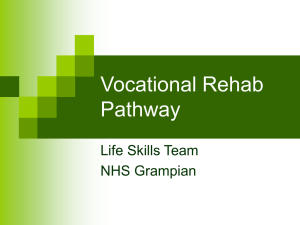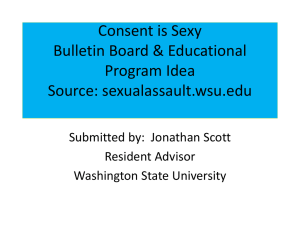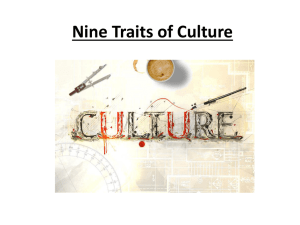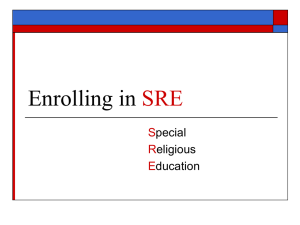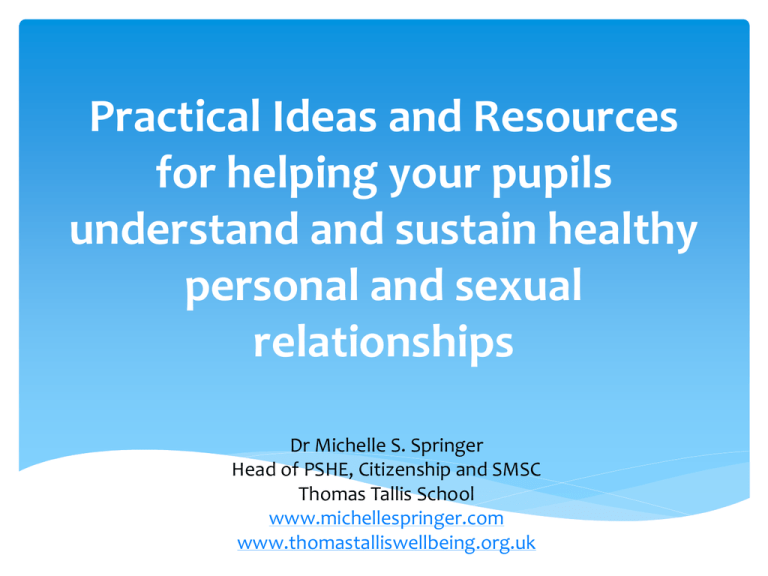
Practical Ideas and Resources
for helping your pupils
understand and sustain healthy
personal and sexual
relationships
Dr Michelle S. Springer
Head of PSHE, Citizenship and SMSC
Thomas Tallis School
www.michellespringer.com
www.thomastalliswellbeing.org.uk
Aims
To provide practical examples of different kinds of
SRE activities
To consider what should and can be covered in SRE
lessons
To identify useful links for SoWs and resources
Where is your school at?
Introductions – talk in pairs. Tell each other;
Your name
Your school
Your role in terms of SRE
How SRE is delivered in your school
Be prepared to tell us about what your partner said
SRE- The Basics
Relationships
Consent
STIs
Pregnancy
Getting help and advice
Exploring feelings and values
Life skills, not just prevention
Safeguarding
Controversial Topics
Homosexuality
Sexual abuse and domestic violence
Pornography, sexting
Abortion
Getting help and advice
The issues that we deal with in SRE (and PSHE in
general) can be sensitive and may touch on feelings
and experiences that are close to you.
If any of the issues that we cover today or in future
lessons affects you then you should seek help or
advice.
There are cards and leaflets available as you leave the
session and contact details are provided on the
poster shown later.
Activities
Class Contract
The Question Box
Personal Space
The Ideal Partner
What do we mean by…?
How easy is it to talk to someone about…?
Mixing Fluids
What’s in the Bag
Condom Demonstration
Healthy and Unhealthy Relationships
Consent
Empathy Glasses
Pornography and Sexting
Class Contract
Safe learning space
Don’t discuss outside the room
Safeguarding – if you have concerns
about abuse or exploitation
Be open
and honest.
However,
Fraser
Guidelines
discourage personal disclosure of own
or others’ personal/private lives
Confidentiality
Openness
Right to pass
Language
Listening to and sharing different points of view
Asking questions
Ensure that students know you are
talking about all kinds of relationships –
Being inclusive
heterosexual, homosexual and bisexual
The Question Box
On each seat there are a number of pieces of paper
These are for any questions you might have that you
would like to keep anonymous
We will answer as many as possible before the end of
the session
Personal Space
Move around the room staying as
far away as possible from anyone
else
Start to move closer to people
See how close you can get to
different people
Can you form a close group?
How comfortable do you feel doing
this?
Are there any people who felt the
need to move away as people got
closer?
The ideal partner
Using the person outline, write all the qualities that
you would want in an ideal partner
You cannot state whether the person is male or
female
Does sex come up?
How? In what context?
What do we mean by…?
Each chair has a number on the back
If I choose your number then you will be given a word
You will state what the words means for you or what you
understand by it
Wider discussion
Does everyone agree?
Do we need to add anything to the meaning?
Can we agree on a common understanding?
How easy is it to talk to someone
about…?
Participants have been given a statement
Place it on the continuum between Easy and Difficult
according to how easy you think it would be to talk
about
Discuss
Change?
Mixing Fluids
Everyone is given a cup with liquid in it and a scenario
Read your scenario and behave as it says
If the scenario says that you have sex with someone then you
should both pour a little of your liquid into each other’s cup
You will be told to stop after about 5 minutes
The facilitator tests each person’s cup with a piece of litmus
paper
Reveal that only one cup was acidic (STI) at the start and now
there are…
Did it matter whether you slept with a lot of people or not?
Did anyone try to talk about contraception or STIs with any of
the partners?
What does the activity demonstrate about the spread of STIs?
What can you do to ensure that you don’t catch an STI?
What’s in the bag?
In groups, take an object from the bag
Answer the questions on your sheet
Present your information to the class
(presentations should be as interactive as
possible and involve all members of the group)
Condom Demonstration
Write down the top 5 worst excuses for not using a
condom
Watch the condom demonstration (silently!)
What did I do wrong?
Key points to identify;
Storage
Use by date
Kite mark
Opening
When to discard
Checking for holes
Healthy and Unhealthy Relationships
Placed around the room are three signs – Healthy
Relationship, Unhealthy Relationship and Abusive
Relationship
Each person has been given 1-3 cards
Place your card/s into the category you feel they most fit
Discuss with the people around you as you put them down
Change any you don’t agree with
When I ring the bell, freeze next to one of the categories
Consent
What are your initial thoughts?
Consent
Have a go at defining the terms “rape” and
“sexual assault”.
It’s harder than you think!!
Rape
• Penile penetration
• of the vagina, anus or mouth
• without consent
• without a reasonable belief in consent
Sexual Assault
• Intentionally touching another person
• sexually
• without that person’s consent
• without a reasonable belief in consent
So what is this reasonable belief in
consent?
Read through the following scenarios
Discuss whether or not there is reasonable belief in
consent
What do you think a court would say? Why?
Sarah meets Tim in a bar lets him buy her
drinks all night.
Does Tim have a reasonable belief that she consents to
having sex with him?
Sarah went back to Tim’s house with
him.
Does Tim have a reasonable belief that she consents to
having sex with him?
Sarah started kissing Tim and let him touch
her breast and put his hand up her skirt.
Does Tim have a reasonable belief that she consents to having
sex with him?
Sarah started having sex with Tim but then
changed her mind and told him to stop.
Tim refused to stop until he was finished.
Does Tim have a reasonable belief that she consents to having
sex with him?
Is this rape?
Tomiwa and her husband Kevin have been married for
a year. They have had consensual sex lots of times…
Tomiwa was tired and really didn’t want to have sex so said no.
Kevin made her have sex anyway.
One night, Kevin came home drunk when Tomiwa was asleep.
He didn’t think she’d mind so started having sex with her while
she was asleep.
Drunken Consent – Thinking points
Does a man have a reasonable belief in consent if…
1) They are both drunk and s/he says yes.
2)They are both drunk and s/he says no.
3)S/he is very drunk but says yes, he is sober and knows how
drunk s/he is.
4)S/he is so drunk that she is slurring her words.
5)S/he is so drunk that s/he passes out.
Quiz
Answer each of the questions in the multiple choice
quiz.
When you have finished you will discuss the answers
as a class
Empathy Glasses
(Usually done with Year 7)
Lessons on LGBT – within a unit on diversity or a
series of lessons on LGBT
Explain empathy
Make glasses with coloured paper
Students write a letter or diary entry from the point
of view of someone who is Lesbian, Gay, Bisexual or
Transgender
Pornography and Sexting
What can you learn about driving a car from this…
Why do people watch pornography?
What results?
Unrealistic body expectations
Which line shows the length of the average erect penis?
Dove Campaign for Real Beauty
Unrealistic “normality” of sexual expectations
Business model for pornography
CEOP Exposed
Which of these lines shows the
length of the average erect penis?
Average size of a flaccid penis 3-4
inches (8.5cm)
Average size of an erect penis 5.5
inches (13.5cm)
Average size that young people
think an erect penis is 12 inches
(30cm)
Difficult Questions
Personal – why are they asking you?
Role model
First time talking on the subject
Openness of discussion
Controversial
Provocative
Interested
Distancing techniques – “That’s an interesting question…”, ground
rules, fictitious characters
Always say if you don’t know
Anonymous questions allow you to choose ones that you are
comfortable with initially and gives you time to seek advice on others
Being candid
Getting help and
advice
Practicing what you
could say to someone
Giving Advice
Knowing where to get
help
Useful links
Bishtraining – resources to buy http://bishtraining.com/
Christopher Winter Project – resources to buy
http://cwpresources.co.uk/home/
CEOP – information for all http://ceop.police.uk/, information for young
people http://www.thinkuknow.co.uk/
Stonewall – https://www.stonewall.org.uk/at_school/
Family Planning Association – sexual health http://www.fpa.org.uk/
PSHE Association – useful information, advice and guidance, plus
resources and training for members http://www.psheassociation.org.uk/
TES
www.thomastalliswellbeing.org.uk – all units and resources freely
available, as well as teacher training and other useful bits
Contact Me
Michelle Springer
mspringer@thomastallis.org.uk
www.michellespringer.com
www.thomastalliswellbeing.org.uk
What are the Fraser Guidelines?
All five of the following must be true;
1. The young person can understand the advice
2. S/he cannot be persuaded to tell a parent or carer about
the situation
3. S/he is going to go ahead with sexual activity whether or
not you give the advice
4. His or her physical or mental health would suffer if you did
not give the advice
5. It is generally in his or her best interests to receive
confidential advice


